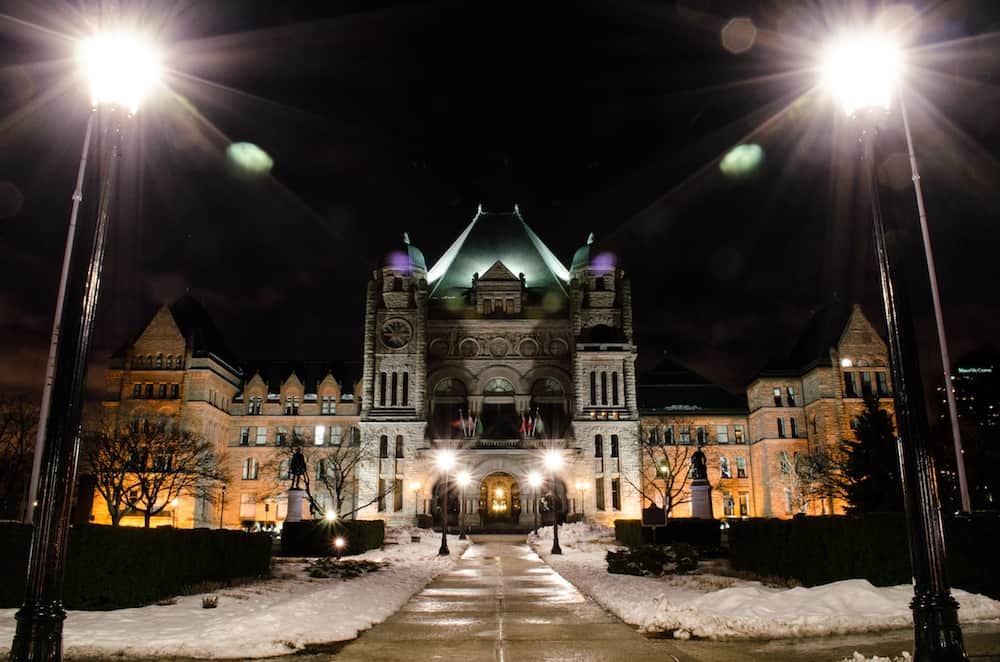Students and climate activists braved the cold weather on January 11 to protest Premier Doug Ford’s climate plan at Queen’s Park as part of Fridays for Future, a global environmental movement started by 16-year-old Swedish climate change activist Greta Thunberg.
The movement encourages students to protest outside of federal or local government buildings on Fridays to urge politicians to create better policies addressing climate change and ensure a sustainable future. In a speech at the United Nations Climate Change Conference last December 14, Thunberg called upon world leaders to act on the effects of climate change, particularly targeting the personal interests of the one per cent.
“You are not mature enough to tell it like it is. Even that burden you leave to us children. But I don’t care about being popular. I care about climate justice and the living planet,” Thunberg said in the speech, which went viral.
Her words inspired a movement of young people including Ava Lyall, a 17-year-old Grade 12 student at Adam Scott Collegiate in Peterborough, Ontario.
Lyall arrived at Queen’s Park with a number of elementary and high school students, some from as far as Peterborough, others from schools downtown, who skipped class Friday morning to support efficient climate action at the greater municipal, provincial, and federal levels.
“We have seen the choices of our parliament affecting what’s going on in Peterborough,” said Lyall. “Programs that were supposed to address climate change, such as bike lanes, that were to be implemented in Peterborough have been cancelled from cap and trade.”
Local politicians were also in attendance at the strike. MPP of Spadina—Fort York Chris Glover addressed the crowd, criticizing the decisions of the Ford government for combatting emissions and abandoning an effective climate action plan.
“This government has made a number of decisions, jeopardizing our future, our environment, and cancelling the cap and trade agreement,” said Glover.
“That’s had a really negative impact,” Glover said. “Not only on our environment because we are not reducing our carbon emissions as fast as we should be — it’s also had an impact on our economy because the money that was coming from the cap and trade system is going into environmental measures.”
Allie Rougeot, a member of the Victoria University Students’ Administrative Council’s Sustainability Commission, was also present at the protest. “As older students, it still really matters for us to show that we’re going to support them,” Rougeot said. “And also say that we’re also part of that generation that’s going to get severely impacted by the effects of climate change.”
Background on the climate plan
The Ford government unveiled its much-anticipated climate change plan on November 29. The plan is modelled after Australia’s carbon emissions reduction fund and features the Ontario Carbon Trust, a $350 million allotment toward large corporations to develop clean technology and reduce emissions overall.
The trust also includes a $50 million Ontario Reverse Auction, which awards businesses for sending in proposals to combat emission reduction.
Ford has been a perennial critic of the federal carbon tax plan, which he claimed was a main cause behind the November announcement that the General Motors plant in Oshawa would be closing this year, though there is no consensus on this.
The new plan was met with scrutiny from Ford’s opponents, including Mike Schreiner, leader of the Green Party of Ontario, who criticized its inefficiency and lower outcomes.
“We need a climate plan, not a litter-reduction plan. This is not a climate plan,” Schreiner said.
Federal Environment Minister Catherine McKenna was also quick to criticize Ford’s plan, calling it “backwards.”
“All I know about Doug Ford’s plan — Premier Ford’s plan — is that they’re going backwards on climate action, that they’re making it free to pollute,” she said.
Ford’s government has reduced the 2030 provincial target for carbon footprint reduction to 18 megatonnes, or 30 per cent below 2005 emission levels. While this is lower than the previous government’s target of 37 per cent below 1990 levels, it remains in accordance with federal and international targets.


